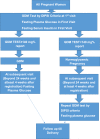Correlation of Insulin Resistance in Pregnancy with Obstetric Outcome
- PMID: 34602761
- PMCID: PMC8440758
- DOI: 10.1007/s13224-021-01426-9
Correlation of Insulin Resistance in Pregnancy with Obstetric Outcome
Abstract
Introduction: Pregnancy is characterized by a series of metabolic changes that promote insulin resistance. This could be due to increase in the plasma levels of one or more pregnancy-related hormones such as oestrogen, progesterone, prolactin, cortisol, and human placental lactogen (HPL). The increased insulin resistance in pregnancy is associated with development of diabetes which has implications for the future gestations also.
Aims and objectives: To determine status of insulin resistance in pregnant women and correlate the presence of insulin resistance with obstetric outcome.
Material and method: A prospective cohort study was conducted in the Department of Obstetrics and Gynaecology, KGMU, Lucknow, over a period of one year. Total 150 pregnant women were enrolled from OPD, out of which 136 women were followed up till delivery. Insulin resistance was calculated by HOMA IR index, twice in whole antenatal period (first in early pregnancy and second in late pregnancy). All women were also tested for GDM by DIPSI test (plasma glucose value after 2 h of 75 gm glucose load irrespective of last meal) as per protocol.
Results: In our study, we found 71 women out of 136 (52.2%) were GDM. Total 30 women out of 136 (22.05%) were GGI (Gestational Glucose Intolerance), and total 38 out of 136 (27.9%) women were found to have insulin resistance using HOMA IR ≥ 2 as cut off. Significant correlation was found in between BMI and insulin resistance (p = 0.001) and between GDM and insulin resistance (p = 0.001). Relative risk of development of complications like Preeclampsia, neonatal hypoglycemia, and respiratory distress syndrome was higher in women having insulin resistance and GDM.
Conclusion: Obstetric complications like preeclampsia, neonatal hypoglycemia, and respiratory distress syndrome are more likely to occur in women with insulin resistance, but larger studies are required to delineate whether insulin resistance alone without development of GDM will have the same implication.
© Federation of Obstetric & Gynecological Societies of India 2021.
Conflict of interest statement
Conflict of interestThe authors declare that they have no conflict of interest.
Figures
Similar articles
-
The Quantose Insulin Resistance Test for Maternal Insulin Resistance: A Pilot Study.Am J Perinatol. 2022 Apr;39(5):513-518. doi: 10.1055/s-0040-1716730. Epub 2020 Sep 7. Am J Perinatol. 2022. PMID: 32894869
-
Gestational glucose intolerance (GGI) and gestational diabetes mellitus (GDM) among antenatal women attending urban community health centers of Lucknow: A cross-sectional study.J Family Med Prim Care. 2023 Apr;12(4):611-618. doi: 10.4103/jfmpc.jfmpc_1134_22. Epub 2023 Apr 17. J Family Med Prim Care. 2023. PMID: 37312767 Free PMC article.
-
Correlation Between Maternal and Fetal Insulin Resistance in Pregnant Women with Gestational Diabetes Mellitus.Clin Lab. 2018 Jun 1;64(6):945-953. doi: 10.7754/Clin.Lab.2018.171214. Clin Lab. 2018. PMID: 29945326
-
Screening and diagnosing gestational diabetes mellitus.Evid Rep Technol Assess (Full Rep). 2012 Oct;(210):1-327. Evid Rep Technol Assess (Full Rep). 2012. PMID: 24423035 Free PMC article. Review.
-
Gestational diabetes, pregnancy hypertension, and late vascular disease.Diabetes Care. 2007 Jul;30 Suppl 2:S246-50. doi: 10.2337/dc07-s224. Diabetes Care. 2007. PMID: 17596480 Review.
Cited by
-
A short-course of low-dose insulin detemir effectively decreases blood glucose levels in gestational diabetic women undergoing dexamethasone treatment to promote newborn lung maturity.Medicine (Baltimore). 2025 Jan 17;104(3):e40547. doi: 10.1097/MD.0000000000040547. Medicine (Baltimore). 2025. PMID: 39833031 Free PMC article.
-
Evaluating the Predictive Value of HOMA-IR in Gestational Diabetes: A Case-Control Study from Romania.Diagnostics (Basel). 2025 Jul 3;15(13):1704. doi: 10.3390/diagnostics15131704. Diagnostics (Basel). 2025. PMID: 40647703 Free PMC article.
References
LinkOut - more resources
Full Text Sources
Research Materials

